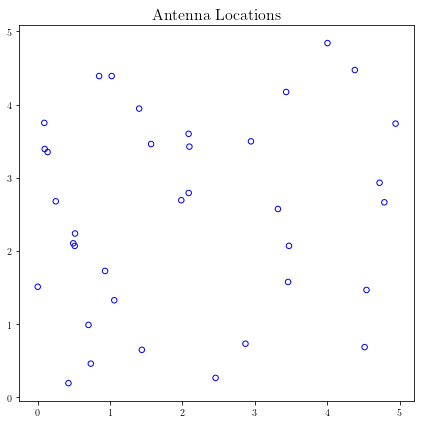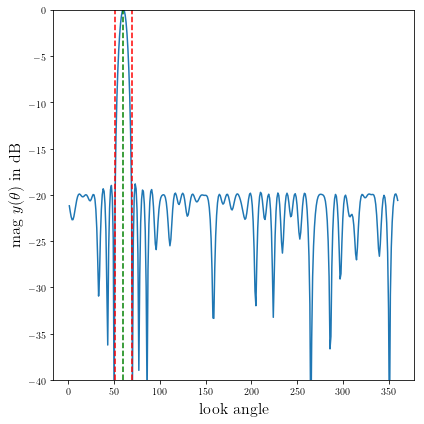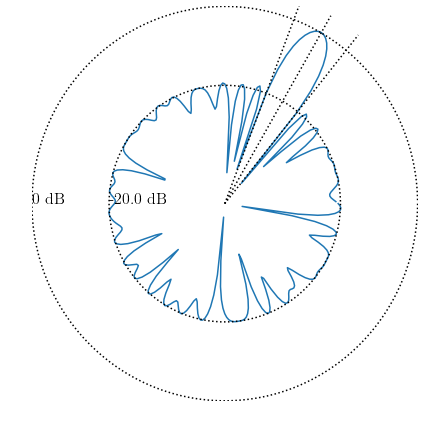Minimize beamwidth of an array with arbitrary 2-D geometry¶
A derivative work by Judson Wilson, 5/14/2014. Adapted (with significant changes) from the CVX example of the same name, by Almir Mutapcic, 2/2/2006.
Topic References:
“Convex optimization examples” lecture notes (EE364) by S. Boyd
“Antenna array pattern synthesis via convex optimization” by H. Lebret and S. Boyd
Introduction¶
This algorithm designs an antenna array such that:
it has unit sensitivity at some target direction
it obeys a constraint on a minimum sidelobe level outside the beam
it minimizes the beamwidth of the pattern.
This is a quasiconvex problem. Define the target direction as \(\theta_{\mbox{tar}}\), and a beamwidth of \(\Delta \theta_{\mbox{bw}}\). The beam occupies the angular interval
Solving for the minimum beamwidth \(\Delta \theta_{\mbox{bw}}\) is performed by bisection, where the interval which contains the optimal value is bisected according to the result of the following feasibility problem:
\(y\) is the antenna array gain pattern (a complex-valued function), \(t_{\mbox{sb}}\) is the maximum allowed sideband gain threshold, and the variables are \(w\) (antenna array weights or shading coefficients). The gain pattern is a linear function of \(w\): \(y(\theta) = w^T a(\theta)\) for some \(a(\theta)\) describing the antenna array configuration and specs.
Once the optimal beamwidth is found, the solution \(w\) is refined with the following optimization:
The implementation below discretizes the angular quantities and their counterparts, such as \(\theta\).
Problem specification and data¶
Antenna array selection¶
Choose either:
A random 2D positioning of antennas.
A uniform 1D positioning of antennas along a line.
A uniform 2D positioning of antennas along a grid.
import cvxpy as cp
import numpy as np
# Select array geometry:
ARRAY_GEOMETRY = '2D_RANDOM'
#ARRAY_GEOMETRY = '1D_UNIFORM_LINE'
#ARRAY_GEOMETRY = '2D_UNIFORM_LATTICE'
Data generation¶
#
# Problem specs.
#
lambda_wl = 1 # wavelength
theta_tar = 60 # target direction
min_sidelobe = -20 # maximum sidelobe level in dB
max_half_beam = 50 # starting half beamwidth (must be feasible)
#
# 2D_RANDOM:
# n randomly located elements in 2D.
#
if ARRAY_GEOMETRY == '2D_RANDOM':
# Set random seed for repeatable experiments.
np.random.seed(1)
# Uniformly distributed on [0,L]-by-[0,L] square.
n = 36
L = 5
loc = L*np.random.random((n,2))
#
# 1D_UNIFORM_LINE:
# Uniform 1D array with n elements with inter-element spacing d.
#
elif ARRAY_GEOMETRY == '1D_UNIFORM_LINE':
n = 30
d = 0.45*lambda_wl
loc = np.hstack(( d * np.array(range(0,n)).reshape(-1, 1), \
np.zeros((n,1)) ))
#
# 2D_UNIFORM_LATTICE:
# Uniform 2D array with m-by-m element with d spacing.
#
elif ARRAY_GEOMETRY == '2D_UNIFORM_LATTICE':
m = 6
n = m**2
d = 0.45*lambda_wl
loc = np.zeros((n, 2))
for x in range(m):
for y in range(m):
loc[m*y+x,:] = [x,y]
loc = loc*d
else:
raise Exception('Undefined array geometry')
#
# Construct optimization data.
#
# Build matrix A that relates w and y(theta), ie, y = A*w.
theta = np.array(range(1, 360+1)).reshape(-1, 1)
A = np.kron(np.cos(np.pi*theta/180), loc[:, 0].T) \
+ np.kron(np.sin(np.pi*theta/180), loc[:, 1].T)
A = np.exp(2*np.pi*1j/lambda_wl*A)
# Target constraint matrix.
ind_closest = np.argmin(np.abs(theta - theta_tar))
Atar = A[ind_closest,:]
Solve using bisection algorithm¶
# Bisection range limits. Reduce by half each step.
halfbeam_bot = 1
halfbeam_top = max_half_beam
print('We are only considering integer values of the half beam-width')
print('(since we are sampling the angle with 1 degree resolution).')
print('')
# Iterate bisection until 1 angular degree of uncertainty.
while halfbeam_top - halfbeam_bot > 1:
# Width in degrees of the current half-beam.
halfbeam_cur = np.ceil( (halfbeam_top + halfbeam_bot)/2.0 )
# Create optimization matrices for the stopband,
# i.e. only A values for the stopband angles.
ind = np.nonzero(np.squeeze(np.array(np.logical_or( \
theta <= (theta_tar-halfbeam_cur), \
theta >= (theta_tar+halfbeam_cur) ))))
As = A[ind[0],:]
#
# Formulate and solve the feasibility antenna array problem.
#
# As of this writing (2014/05/14) cvxpy does not do complex valued math,
# so the real and complex values must be stored separately as reals
# and operated on as follows:
# Let any vector or matrix be represented as a+bj, or A+Bj.
# Vectors are stored [a; b] and matrices as [A -B; B A]:
# Atar as [A -B; B A]
Atar_R = Atar.real
Atar_I = Atar.imag
neg_Atar_I = -Atar_I
Atar_RI = np.block([[Atar_R, neg_Atar_I], [Atar_I, Atar_R]])
# As as [A -B; B A]
As_R = As.real
As_I = As.imag
neg_As_I = -As_I
As_RI = np.block([[As_R, neg_As_I], [As_I, As_R]])
As_RI_top = np.block([As_R, neg_As_I])
As_RI_bot = np.block([As_I, As_R])
# 1-vector as [1, 0] since no imaginary part
realones_ri = np.array([1.0, 0.0])
# Create cvxpy variables and constraints
w_ri = cp.Variable(shape=(2*n))
constraints = [ Atar_RI*w_ri == realones_ri]
# Must add complex valued constraint
# abs(As*w <= 10**(min_sidelobe/20)) row by row by hand.
# TODO: Future version use norms() or complex math
# when these features become available in cvxpy.
for i in range(As.shape[0]):
#Make a matrix whos product with w_ri is a 2-vector
#which is the real and imag component of a row of As*w
As_ri_row = np.vstack((As_RI_top[i, :], As_RI_bot[i, :]))
constraints.append( \
cp.norm(As_ri_row*w_ri) <= 10**(min_sidelobe/20) )
# Form and solve problem.
obj = cp.Minimize(0)
prob = cp.Problem(obj, constraints)
prob.solve(solver=cp.CVXOPT)
# Bisection (or fail).
if prob.status == cp.OPTIMAL:
print('Problem is feasible for half beam-width = {}'
' degress'.format(halfbeam_cur))
halfbeam_top = halfbeam_cur
elif prob.status == cp.INFEASIBLE:
print('Problem is not feasible for half beam-width = {}'
' degress'.format(halfbeam_cur))
halfbeam_bot = halfbeam_cur
else:
raise Exception('CVXPY Error')
# Optimal beamwidth.
halfbeam = halfbeam_top
print('Optimum half beam-width for given specs is {}'.format(halfbeam))
# Compute the minimum noise design for the optimal beamwidth
ind = np.nonzero(np.squeeze(np.array(np.logical_or( \
theta <= (theta_tar-halfbeam), \
theta >= (theta_tar+halfbeam) ))))
As = A[ind[0],:]
# As as [A -B; B A]
# See earlier calculations for real/imaginary representation
As_R = As.real
As_I = As.imag
neg_As_I = -As_I
As_RI = np.block([[As_R, neg_As_I], [As_I, As_R]])
As_RI_top = np.block([As_R, neg_As_I])
As_RI_bot = np.block([As_I, As_R])
constraints = [ Atar_RI*w_ri == realones_ri]
# Same constraint as a above, on new As (hense different
# actual number of constraints). See comments above.
for i in range(As.shape[0]):
As_ri_row = np.vstack((As_RI_top[i, :], As_RI_bot[i, :]))
constraints.append( \
cp.norm(As_ri_row*w_ri) <= 10**(min_sidelobe/20) )
# Form and solve problem.
# Note the new objective!
obj = cp.Minimize(cp.norm(w_ri))
prob = cp.Problem(obj, constraints)
prob.solve(solver=cp.SCS)
#if prob.status != cp.OPTIMAL:
# raise Exception('CVXPY Error')
print("final objective value: {}".format(obj.value))
We are only considering integer values of the half beam-width
(since we are sampling the angle with 1 degree resolution).
Problem is feasible for half beam-width = 26.0 degress
Problem is feasible for half beam-width = 14.0 degress
Problem is not feasible for half beam-width = 8.0 degress
Problem is feasible for half beam-width = 11.0 degress
Problem is feasible for half beam-width = 10.0 degress
Problem is feasible for half beam-width = 9.0 degress
Optimum half beam-width for given specs is 9.0
final objective value: 1.6616084212553195
Result plots¶
import matplotlib.pyplot as plt
# Show plot inline in ipython.
%matplotlib inline
# Plot properties.
plt.rc('text', usetex=True)
plt.rc('font', family='serif')
#
# First Figure: Antenna Locations
#
plt.figure(figsize=(6, 6))
plt.scatter(loc[:, 0], loc[:, 1],
s=30, facecolors='none', edgecolors='b')
plt.title('Antenna Locations', fontsize=16)
plt.tight_layout()
plt.show()
#
# Second Plot: Array Pattern
#
# Complex valued math to calculate y = A*w_im;
# See comments in code above regarding complex representation as reals.
A_R = A.real
A_I = A.imag
neg_A_I = -A_I
A_RI = np.block([[A_R, neg_A_I], [A_I, A_R]]);
y = A_RI.dot(w_ri.value)
y = y[0:int(y.shape[0]/2)] + 1j*y[int(y.shape[0]/2):] #now native complex
plt.figure(figsize=(6,6))
ymin, ymax = -40, 0
plt.plot(np.arange(360)+1, np.array(20*np.log10(np.abs(y))))
plt.plot([theta_tar, theta_tar], [ymin, ymax], 'g--')
plt.plot([theta_tar+halfbeam, theta_tar+halfbeam], [ymin, ymax], 'r--')
plt.plot([theta_tar-halfbeam, theta_tar-halfbeam], [ymin, ymax], 'r--')
plt.xlabel('look angle', fontsize=16)
plt.ylabel(r'mag $y(\theta)$ in dB', fontsize=16)
plt.ylim(ymin, ymax)
plt.tight_layout()
plt.show()
#
# Third Plot: Polar Pattern
#
plt.figure(figsize=(6,6))
zerodB = 50
dBY = 20*np.log10(np.abs(y)) + zerodB
plt.plot(dBY * np.cos(np.pi*theta.flatten()/180),
dBY * np.sin(np.pi*theta.flatten()/180))
plt.xlim(-zerodB, zerodB)
plt.ylim(-zerodB, zerodB)
plt.axis('off')
# 0 dB level.
plt.plot(zerodB*np.cos(np.pi*theta.flatten()/180),
zerodB*np.sin(np.pi*theta.flatten()/180), 'k:')
plt.text(-zerodB,0,'0 dB', fontsize=16)
# Max sideband level.
m=min_sidelobe + zerodB
plt.plot(m*np.cos(np.pi*theta.flatten()/180),
m*np.sin(np.pi*theta.flatten()/180), 'k:')
plt.text(-m,0,'{:.1f} dB'.format(min_sidelobe), fontsize=16)
#Lobe center and boundaries angles.
theta_1 = theta_tar+halfbeam
theta_2 = theta_tar-halfbeam
plt.plot([0, 55*np.cos(theta_tar*np.pi/180)], \
[0, 55*np.sin(theta_tar*np.pi/180)], 'k:')
plt.plot([0, 55*np.cos(theta_1*np.pi/180)], \
[0, 55*np.sin(theta_1*np.pi/180)], 'k:')
plt.plot([0, 55*np.cos(theta_2*np.pi/180)], \
[0, 55*np.sin(theta_2*np.pi/180)], 'k:')
#Show plot.
plt.tight_layout()
plt.show()


